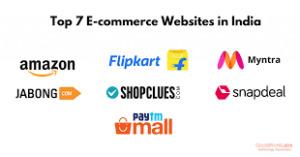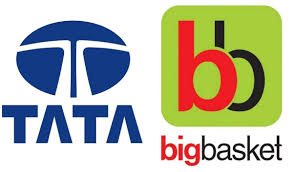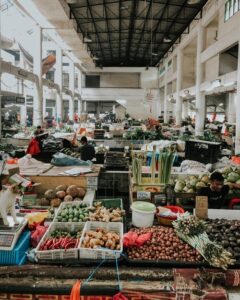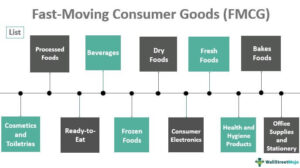India’s FMCG Consumer Rides The E-commerce Gateway.
FMCG Customer Goes Digital. E-commerce Lethal And Vital.
“Better customer engagement, All around”.

The novel corona virus pandemic gave e-commerce adoption an unprecedented boost and brought huge sales increases to some retailers. New data suggests, however, that retailers of all sizes did not benefit equally from the e-commerce boom.
The biggest retailers in the U.S. including Amazon.com, Walmart and Target received the majority of the windfall from the public’s pandemic-era e-commerce habits, according to a study by Digital Commerce 360, reported on Inc.
Know more about Nifty Fmcg stock market
Online Sales Exploded in 2020–but Mostly for Retail Giants.
The research found that the top 500 companies generated $849.5 billion in online sales in 2020, a 45.3 percent increase year-over-year and the biggest jump since Digital Commerce 360 began tracking the statistic in 2006. While retailers of all sizes did benefit from online sales, new customers largely turned to familiar, big brands, allowing those retail enterprises to take share from smaller operators.

The first movers advantage and the ability to more adequately manage shipping and supply chain issues throughout the pandemic, this was not the case at every point during the pandemic.
In March of 2020, e-commerce’s biggest player, Amazon, ran into problems fulfilling orders on time. Long waits and order cancellations became common, and for a time during the pandemic’s first U.S. wave the e-retailer stopped fulfilling orders for items deemed “non-essential” entirely.
It’s been a terrible time for retailers without a remarkable retail value proposition, a well harmonized shopping experience and value added benefits from their physical assets to open stores for many, many years. Conversely, even prior to the pandemic, many retailers across a wide spectrum of sectors successfully opened Super Markets to Kirana stores. The Corona pandemic demonstrated is a growing need to be remarkable, to see the customer as the channel and to respond to the increasingly hybrid nature of shopping, expanded role of stores in support of digitally-driven commerce. Integration of e-commerce into the retail experience has improved sophisticated customer expectations. Retailers are continually rewriting their customer service-level agreements (SLAs) to reflect the increasing demands for free shipping, fast delivery and expedited turnaround on click and collect orders.
Shifting shoppers to digital channels relieves the pressure on contact center. And by addressing the right use cases in the right way, the digital shift also increases customer satisfaction, giving them more control and faster resolutions in the channels they are already using. Delivering secure, personalized, and innovative shopping experiences to meet customers’ growing expectations requires more than just ambition — it takes careful planning and the right solutions.
For example, toys and hobbies retailers jumped an average 24 spots in the rankings, according to analysis in USA. In contrast, apparel retailers dropped an average 15 positions in the Top 500. Food and beverage merchants moved up an average 23 ranks, whereas jewelry retailers fell an average 10 spots.

These patterns coincide with consumer shopping habits in 2020 and the fastest-growing merchandise categories. Food, toys, electronics, hardware, sporting goods and housewares advanced the most online last year. Food and beverage retailers, for instance, grew 104.8% online, as stay-at-home mandates drove shoppers online—often for the first time—to order groceries for pickup and delivery.
Online fashion industry witnessed an order volume growth of 51 per cent and gross merchant value (GMV) increase of 45 per cent in FY21 as compared to the previous financial year, a report by Unicommerce said on Thursday. The faster volume growth as compared to GMV has led to a marginal decline of 4 per cent in the average order value, the report titled ‘Fashion E-commerce Report’ said.
Unicommerce, e-commerce focused SaaS (software as a service) platform, analysed fashion trends for the period of FY2021 and FY2020 with a sample size of over 70 million orders.
“Fashion labels have been at the forefront of re-inventing, re-strategies, and re-aligning themselves to rapidly evolving business environments and changing consumer needs. The industry has also observed multiple retail brands
Toys and hobbies retailers, which include everything from merchants that sell puzzles and video game consoles to musical instruments, jumped 68.2% year over year. Three toys and hobbies retailers appear in the top 15 fastest growers list, and it’s worth noting that no retailer in this category was among the 15 fastest growers in the previous two editions of the Top 500, showing the change in purchasing habits fueled by quarantine in the USA.

Though India’s near-term prospects have been hit hard by a corona virus second wave, the country promises huge growth potential once the pandemic ends. Its increasingly connected population and aspiration, middle class remind many global businesses of China, which in a few years became the world’s biggest internet market by population.
India’s online market is expected to be worth $85.3 billion by 2024, according to Forrester Research. Facebook, Walmart and others have joined Amazon in investing heavily in the country.
Online groceries are a small but growing piece of the market. For now, Indians shop online primarily to buy fashion products and cellphones. But a chain of brick-and-mortar stores could be a valuable asset for conquering the online business, for many of the same reasons Amazon bought Whole Foods four years ago to build its grocery business in the United States. Grocery stores can make handy distribution centers and bring both brand-name recognition and long-term relationships with suppliers.

One for the long haul,this is a 10-,15-year game.online program prepares you to thrive in the evolving retail landscape. With an eye to both the future of retail and the mind of today’s consumer, this program focuses on the emerging technologies changing how we think of retail today. Courses on topics such as merchandising, branding, retail marketing, style analytics, and product development give you a well-rounded background in the industry and set you up for success.
Big Bazaar owned by the Future Group, which owns 1,500 supermarkets, snack shops and fashion outlets in 400 cities in India. That brick-and-mortar footprint makes it a prize for companies that, paradoxically, want a piece of India’s fast growing technology and e-commerce market.

Those companies include Amazon. It is betting big on India, already accounts for about one-third of e-commerce sales.
The easing of Lock down restrictions will allow consumers to buy goods that they badly need and help small businesses unlock their operations to a certain extent. It has been welcomed because Maharashtra also houses large warehouses of ecommerce firms. It would be relatively easier for e-tailers and sellers to navigate logistics though the easing comes with some riders.
India’s retail battle is now underway, and at stake is the nation’s retail industry valued at $883 billion in 2020 and estimated to grow to $1.24 trillion by 2024 and $1.75 trillion by 2026.
Following Amazon and Reliance, Tata Group, in recent weeks, has been on an acquisition spree. Earlier this week, it was announced that Tata Digital would buy a majority state in the digital health company 1MG. Interestingly, this investment follows Reliance Retail’s acquisition of Netmeds in August 2020 and Amazon’s launch of its digital pharmacy in Karnataka.
Tata Group, in April this year, acquired BigBasket, thus flexing its muscles against Reliance’s JioMart and Amazon Pantry.
Following Amazon’s array of services, Reliance and Tata’s are now looking to create a super app modeled on the lines of WeChat in China. This super app is supposed to serve as a digital retail extension to the other services offered by these conglomerates through their stores across many cities in India.

Amazon, with its e-commerce offerings, is already the biggest online marketplace in the world.
By late 2020, Amazon’s online marketplace in India had close to 0.7 million sellers. With the company adding close to 20,000 sellers in the preceding months, the growth has been steady and significant. Jeff Bezos, however, wants to onboard more than 10 million sellers by 2025 with an aim to dominate the largest free market on the planet.
On the other hand, Reliance Retail, with 45 subsidiaries which include Reliance Fresh, Reliance Digital, Reliance Footprint, Hamleys, JioMart, Netmeds, and Urban Ladder, is already emerging as the leading player in India, given its elaborate network in rural India.
While Reliance, with more than 11,000 stores, leads Amazon’s network when it comes to traditional retail, it has also strengthened its e-commerce platform, JioMart, after a flurry of investments across 2020. Reliance Retail Ventures raised close to $6.4 billion from Silver Lake, KKR, Mubadala, Abu Dhabi Investment Authority, GIC, TPG, General Atlantic and Saudi Arabia’s Public Investment Fund.
Reliance will also look to challenge Amazon in the grocery business, given Mukesh Ambani has already announced an outreach programme around the launch of JioMart, stating that the digital transformation would not only help 120 million farmers but also 30 million small merchants, 60 million small and medium enterprises.

After the launch of JioMart last year, in the middle of the Covid-19-forced lockdown, Reliance made the next big move by acquiring a cash-starved Future Group. In the deal, the Future Group was selling its retail, wholesale, logistics, and warehousing businesses to the Reliance Group.
The highlight of the deal, from the Reliance perspective, was getting ownership of the retail chain ‘Big Bazaar’, fashion and clothes supermarket chain ‘Brand Factory’, and other retail units, thus adding more muscle to Reliance Retail, furthering its invincibility in the Indian market.
Amazon, clearly, had its sight set on the Future Group’s retail business, around 1500 stores, which would have supplied it with the brick and mortar ammunition to take on Reliance’s physical presence in the market. Losing Future Group to Reliance would leave Amazon far behind in the physical retail space.
Further challenging Amazon, Reliance has introduced an array of services for its super app last year.
These services include Jio GigaFiber, Jio Cinema, Jio Music, Jio TV, Jio HealthHub, Jio News, Reliance Digital, Jio Engage, Jio Cloud and Jio Switch. Apart from the services already provided by Jio, in the future, the services could extend to education, logistics, food, farming, fashion, dating, professional networking, and so forth. Collaboration with Facebook and Google via Reliance Jio will also strengthen the overall Jio ecosystem, aiding the growth of its retail arm.
In the midst of this fierce battle, Tata Group has been quietly emerging as a potential dark horse.
Acquisition of BigBasket was an obvious step to venture into the retail space for Tata Group. Last year, during the lockdown, against Reliance JioMart’s 400,000, BigBasket was registering close to 300,000 orders per day. Amazon and Grofers had around 100,000 orders each per day.
BigBasket has also been actively working with farmers. Through their farmer connect programme, launched in 2016, the company has simplified the supply chain in order to ensure the quality of the fresh produce.
This has helped farmers raise their incomes by 10-15 per cent. The company, by 2019, had 30 collection centres across the country. Today, it sources 80 per cent of the fruits and vegetables directly from the farmers, thus taking the middleman out of the equation.
Amazon, like BigBasket and JioMart, has already been working with farmers.
In 2019, Amazon was already running a pilot project in Pune to source fresh produce directly from the farmers under its farm-to-fork initiative.
The idea was then to sell the products through Amazon Pantry and Amazon Fresh. In 2017, Amazon made a $500 million investment in the food and grocery segment in India after approval from the government.
Amazon has also been working overtime to onboard kirana stores to strengthen its e-commerce segment. In April 2020, Amazon India announced an investment of $1.3 billion to onboard 5,000 local kirana stores across 100 cities.

Barring BigBasket, CureFit, and NetMeds, the Tata Group plans to integrate its other subsidiaries for the super app.
These would include consumer durables, financial products and telecom. The shopping app Tata CLiQ, grocery e-store StarQuik, and online electronics platform Croma could also be integrated within the app. Tata already has a prominent online presence with Tanishq jewellery outlets, Titan, Star Bazaar retail stores, Taj Hotels, and Westside — a clothing brand.
For Amazon, Reliance, and Tata, the numbers justify the expansion exuberance. In the final quarter of 2020, a pandemic year, India’s consumer spending in the retail sector was almost $290 billion. The online grocery market alone was worth more than $3 billion in 2020.

The share of traditional retail in the overall market is expected to fall from 88 per cent in FY19 to less than 75 per cent in FY21, as per estimations. However, organised retail and e-commerce are expected to go from 9 per cent to 18 per cent and from 3 per cent to 7 per cent for the same period, indicating a significant shift towards digital retail.
Walmart, another player in the retail sector, will also emerge with time as a tough competitor to the Big Three. For now, it is between the three conglomerates to fight it out in a market of 1.3 billion people and a sector valued at close to $1 trillion.
Stores matter and the pandemic has created new opportunities in locations that may have been unattainable prior to the pandemic — and at a cost and lease terms that are very attractive. Store openings are necessarily not related to a digital shift or online vs. offline — retailers need to do both. The thoughtful retailers understand that the physical store is not just about facilitating a sales transaction any more, and so despite the acceleration to digital, the store will become even more important.
The realization for online retailers is that when looked at holistically, physical retail makes sense to balance things out – cost of customer acquisition, growth, distribution and delivery.
But the new age retailers will do well by keeping in mind what caused the old model to fail – too much expansion too soon, not thinking holistically about the impact of the store lane on online sales, poor customer experience and assortments.
The advantage for online brands is that they can benefit from others’ experience. Hopefully they will only make new mistakes.
On the contrary most successful retailers are those who are able to leverage multiple channels. As we learn more about the “halo” effect and are able to track and analyze human movement patterns, the data tells us how critical locations are to successful retail.
Only Time will tell the effects of the upheaval. What would happen to the groceries, supermarkets,salesmen,distributors,stockists,wholesalers and the FMCG distribution network.
And while at it Manufacturers,Digital platforms.Consumers are bound to benefit better and affordable rates.
The tide is turning…
We remain indebted to all Blogs used as reference and for perspective . Our Sincere Thank You To All From FMCG Sector.
Team DigitalGumma.
Top most festival Products FMCG consumers search today
World Wide Festive Trends Decoded What Indian festive consumers seek...
Read MoreHow right selection of FMCG Salesmen improves brand market share
How can FMCG Companies improve salesman’s technique in order to...
Read MoreHow most searched Fmcg sales and marketing words help newbie salesman
Why undestand FMCG sales management? Sales management is the process...
Read MoreHow Successful FMCG Salesman Starts his Day, a guide
How does one become a good sales executive in the...
Read More





